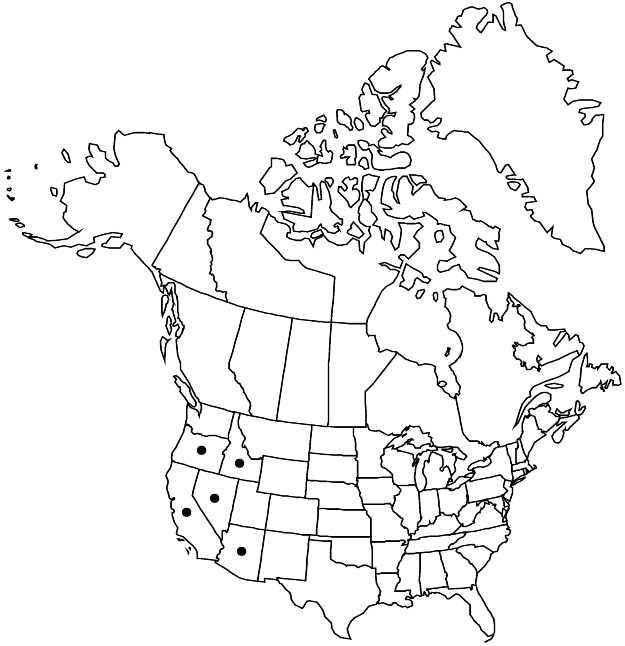Difference between revisions of "Chorizanthe brevicornu"
in W. H. Emory, Rep. U.S. Mex. Bound. 2(1): 177. 1859.
FNA>Volume Importer |
FNA>Volume Importer |
||
| Line 21: | Line 21: | ||
|distribution=w United States;nw Mexico. | |distribution=w United States;nw Mexico. | ||
|discussion=<p>Varieties 2 (2 in the flora).</p><!-- | |discussion=<p>Varieties 2 (2 in the flora).</p><!-- | ||
| − | --><p>Chorizanthe brevicornu has stems and branches that easily disarticulate at the nodes. Dried specimens often are reduced to a mere jumble without careful handling. The vegetative fragments will not regenerate new plants, but the involucres (each with a single flower bearing a single achene) easily disarticulate from the parent plant, and with the aid of the awns on the teeth of the involucre, may be readily distributed.</p> | + | --><p><i>Chorizanthe brevicornu</i> has stems and branches that easily disarticulate at the nodes. Dried specimens often are reduced to a mere jumble without careful handling. The vegetative fragments will not regenerate new plants, but the involucres (each with a single flower bearing a single achene) easily disarticulate from the parent plant, and with the aid of the awns on the teeth of the involucre, may be readily distributed.</p> |
|tables= | |tables= | ||
|references= | |references= | ||
| Line 56: | Line 56: | ||
|publication year=1859 | |publication year=1859 | ||
|special status= | |special status= | ||
| − | |source xml=https://jpend@bitbucket.org/aafc-mbb/fna-data-curation.git/src/ | + | |source xml=https://jpend@bitbucket.org/aafc-mbb/fna-data-curation.git/src/8f726806613d60c220dc4493de13607dd3150896/coarse_grained_fna_xml/V5/V5_985.xml |
|subfamily=Polygonaceae subfam. Eriogonoideae | |subfamily=Polygonaceae subfam. Eriogonoideae | ||
|genus=Chorizanthe | |genus=Chorizanthe | ||
Revision as of 17:42, 18 September 2019
Plants spreading to erect, 0.5–3(–5) × 0.5–3 dm, thinly pubescent, often with appressed hairs, infrequently somewhat strigose or glabrate. Leaves basal; petiole 0.5–2 cm; blade oblanceolate to narrowly elliptic or spatulate, (1–)1.5–3(–4) × 0.1–1 cm, pubescent. Inflorescences green; bracts 2, similar to proximal leaf blades only more reduced, 0.3–1(–1.5) cm × 1–2.5 mm, becoming sessile and scalelike at distal nodes, linear, acicular, awns 0.2–0.5 mm. Involucres 1, green, 3–5 mm, not corrugate, thinly strigose; teeth divergent, 0.4–1.2 mm; awns uncinate, 0.2–0.5 mm. Flowers included; perianth greenish white to white or pale yellowish white, cylindric, 2–4 mm; tepals connate 3/4 their length, monomorphic, linear to narrowly oblanceolate, acute, entire apically; stamens slightly exserted; filaments distinct, 2–3.5 mm, glabrous; anthers white to pale yellow, ovate, 0.3–0.4 mm. Achenes dark brown, lenticular, 3–4 mm.
Distribution

w United States, nw Mexico.
Discussion
Varieties 2 (2 in the flora).
Chorizanthe brevicornu has stems and branches that easily disarticulate at the nodes. Dried specimens often are reduced to a mere jumble without careful handling. The vegetative fragments will not regenerate new plants, but the involucres (each with a single flower bearing a single achene) easily disarticulate from the parent plant, and with the aid of the awns on the teeth of the involucre, may be readily distributed.
Selected References
None.
Key
| 1 | Leaf blades oblanceolate to narrowly elliptic, 0.1-0.3(-0.5) cm wide; involucres prominently ribbed at maturity; Mojave and Sonoran deserts | Chorizanthe brevicornu var. brevicornu |
| 1 | Leaf blades broadly oblanceolate to broadly spatulate, 0.5-1 cm wide; involucres obscurely ribbed at maturity; Great Basin Desert and Snake River Plains | Chorizanthe brevicornu var. spathulata |